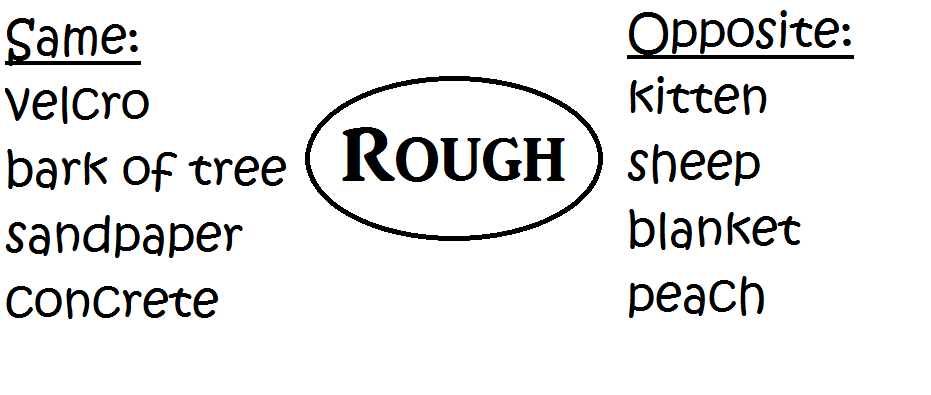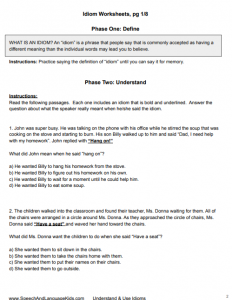How to Teach Idioms and Figurative Language to Kids and Teens
Have you been bending over backwards trying to teach your students idioms? Are they left high and dry when idioms are used in their classrooms? Well I’m going to take the bull by the horns and knock your socks off with some fabulous activities for working on figurative language in speech therapy!
What is Figurative Language?
Figurative language, also called abstract language or non-literal language, is anything we say where what we mean is not exactly the same as the literal meaning of those words. For example, when I say I will knock your socks off, I don’t mean that your socks will literally come off of your feet. I mean that I will impress you. Figurative language is specific to each language and even to specific groups of people who use that language. Each culture has its own sayings and expressions that have different meanings to them.
The following are all types of figurative language/abstract language:
- Similes and Metaphors
- Idioms, also known as figures of speech
- Hyperbole
- Sarcasm
What is an Idiom in Figurative Language?
An idiom is a type of figurative language that is a phrase that people say that is commonly accepted as having a different meaning that the individual words may lead you to believe. For example, stating that “it’s raining cats and dogs” does not mean that there are literally cats and dogs falling from the sky. Instead, it means that it is raining heavily. Many of the idioms in English have roots back to older ways of saying things.
Idioms are a form of figurative language and are often not well-understood by children with language disorders. While there is no magical age by which children should understand idioms, it is reasonable to generalize that a 5-year-old knows very few idioms and an adult knows (and uses) a ton. Children should gradually get better at using idioms and should be able to use quite a few idioms in the middle school years and even more in the high school years.
Idiom Examples (Figurative Language):
- Hang on = Wait a moment
- Have a seat = Sit down
- You’re driving me up the wall = you’re annoying me
- Bend over backwards = Do everything you can
- Fishy = Weird or Odd
- Knocked my socks off = Impressed me very much
- Pulling my leg = Kidding me, making a joke
- Horsing around = messing around, playing
- Let the cat out of the bag = Told the secret or let someone know something they weren’t supposed to know
- Play it by ear = Improvise or make it up as you go
- Give it a shot = Try to do it
- That was a piece of cake = That was easy
- Slipped my mind = I forgot
- In hot water = In trouble
- Having second thoughts = Changed your mind
- Out of the blue = Random or unexpected
- I’m all ears = I’m listening
- In the same boat = In the same situation
- Don’t see eye to eye = Don’t agree
- Call it a day = Quit doing something for now
Idioms Speech Therapy:
For children who are struggling to learn or understand idioms, speech therapy can help. Idioms speech therapy will focus on helping children understand the meaning of these common (and sometimes uncommon) figures of speech that have non-literal meanings. Here are the steps to doing speech therapy to help a child learn idioms:
- Have the child read a passage (or read it aloud for him) that contains an idiom. Ask the child to guess the meaning of the idiom based on the context in which it is given.
- Have the child come up with a scenario in which that idiom might be used (aside from the example already given). Role play the scenario and have the child use the idiom.
- Give the child an assignment to use the idiom at an appropriate time sometime before your next session. Ask him to write down in a journal when he used it and what the context was. Review during the next session.
- During your next session, ask the child to tell you the true meaning of the idiom. For this, just say the idiom out loud, don’t give it in context. If the child is unable to tell you the meaning, repeat the steps above.
- Repeat the steps above with a new idiom.
Examples of Idioms in Passages:
- John was super busy. He was talking on the phone with his office while he stirred the soup that was cooking on the stove and starting to burn. His son Billy walked up to him and said “Dad, I need help with my homework”. John replied with “Hang on!”
- The children walked into the classroom and found their teacher, Ms. Donna waiting for them. All of the chairs were arranged in a circle around Ms. Donna. As they approached the circle of chairs, Ms. Donna said “Have a seat” and waved her hand toward the chairs.
- Batson was clearly having a rough day. The children in her class were running around the classroom and screaming. There were toys and art supplies everywhere. Three children were pulling on her clothes and singing as loudly as they could. Mrs. Batson looked at the children and said “You’re driving me up the wall!”
What are Similes and Metaphors in Figurative Language?
What is a Simile?
A simile is a comparison between two unlike things that uses the word “like” or “as”. For example, you could say your Grandma is as friendly as a grizzly bear (meaning that she’s not very friendly) or that your socks are as warm as a fireplace (meaning that they are very warm).
How to Teach Similes to Children:
Step One: On a piece of paper, write an adjective in the middle. On the left side of the paper, write objects that can be described by that adjective. On the right side of the paper, write objects that are not described by that adjective. You should have a list like this:

Step Two: Have the child choose two items from either side of the paper and create a simile for them. For example, you could use “this blanket is as rough as a kitten”. You can also do this with a verb in the middle and the word “like” in the simile, such as “you jump like a kangaroo”.
Step Three: Practice using some of the similes that the child created in written or spoken language. Come up with scenarios or situations where it would be appropriate to use those similes and either role play scenarios or write out paragraphs that include them.
What is a Metaphor?
A metaphor is a comparison between two unlike things but instead of using “like” or “as”, you just replace one word with another word. For example, you might say that your child is a doll, or that your chocolate bar is heaven.
Literature is full of metaphors. Go through a pleasure-reading book with the child and pick out any metaphors that come up. Talk with the child about what the literal meaning of the metaphor would mean and ask if he thinks the author meant that. Then, decide on the figurative meaning that the author was going for. For example, if the author wrote, “Jason was a pig at dinner”, ask your child if the author meant that he actually turned into a pig. No, probably not. Then help the child determine that the author really meant he ate sloppily like a pig would.
Additional Resources on Idioms, Figurative Language, and Abstract Language:
Listen to this Information on Idioms, Figurative Language as a Podcast:

About the Author: Carrie Clark, MA CCC-SLP
Hi, I’m Carrie! I’m a speech-language pathologist from Columbia, Missouri, USA. I’ve worked with children and teenagers of all ages in schools, preschools, and even my own private practice. I love digging through the research on speech and language topics and breaking it down into step-by-step plans for my followers.
Fun Fact: Peanut M&Ms are my favorite guilty pleasure food. I could eat them all day. Mmmmmm….
Connect with Me:
Podcast: Play in new window | Download | Embed
Subscribe: RSS










This webinar was wonderful. Very clear and full of good info. Thank you!
You’re welcome!
Thanks Carrie for some great information. I printed out the idioms worksheet for my folder as well as downloaded it into my ibooks for travel.
Awesome info…I am Definitely going to use with my kiddos!!
Thanks a ton…you are great!!
You are welcome and thank you for the kind words! Glad you enjoyed the materials!
Thank you a lot this was a BIG help [=
Thank you…..
What are big love to your sharing!
i extremely like it as it is very much helpful to not only kids but also adults.
It’s a good information!